Avoid getting scammed by fake "Netflix - Update Your Account" emails
Phishing/ScamAlso Known As: "Netflix - Update Your Account Information" phishing email
Get free scan and check if your device is infected.
Remove it nowTo use full-featured product, you have to purchase a license for Combo Cleaner. Seven days free trial available. Combo Cleaner is owned and operated by RCS LT, the parent company of PCRisk.com.
What kind of email is "Netflix - Update Your Account Information"?
After investigating the "Netflix - Update Your Account Information" email, we determined that it is spam. The letter is presented as a notification from Netflix alerting the recipient that their account risks suspension. This email promotes a phishing website targeting log-in credentials and/or other sensitive information. It must be stressed that this mail is in no way associated with the actual Netflix streaming platform.
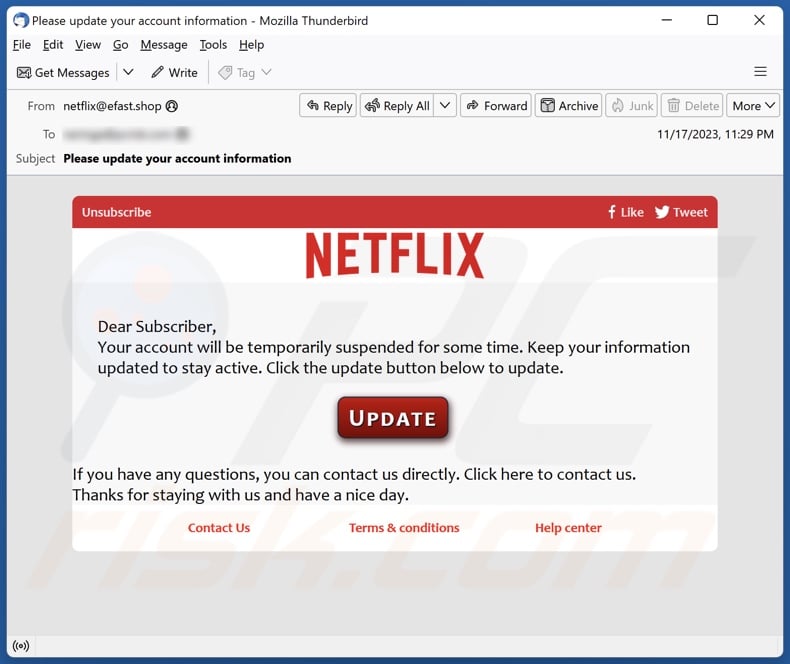
"Netflix - Update Your Account Information" email scam overview
The spam email with the subject "Please update your account information" (may vary) informs the recipient that their Netflix account will be suspended temporarily. The letter instructs to update the account information to keep it active.
It must be mentioned that all these claims are false, and this mail is not associated with the real Netflix subscription-based streaming platform.
At the time of research, the "UPDATE" button in this email redirected to a dead (i.e., nonfunctional) webpage. It must be mentioned that this could be rectified in potential future releases of this spam.
Based on our experience researching spam mail, we can conclude that this letter was intended to promote a phishing website – a type of page designed to record entered data and send it to scammers. What kind of information was originally targeted by this email is unknown.
The most likely data would include Netflix or email account log-in credentials and financial details necessary for subscription (e.g., credit card numbers, etc.). Cyber criminals can use stolen financial information to facilitate fraudulent transactions and online purchases.
To summarize, by trusting an email like "Netflix - Update Your Account Information" – users can experience serious privacy issues, financial losses, and even identity theft.
If you have already provided your log-in credentials – change the passwords of all possibly exposed accounts and inform their official support without delay. However, if the disclosed data was of a different personal nature (e.g., credit card numbers, ID card details, etc.) – immediately contact the appropriate authorities.
| Name | "Netflix - Update Your Account Information" phishing email |
| Threat Type | Phishing, Scam, Social Engineering, Fraud |
| Fake Claim | Recipient's Netflix account will be suspended unless it is updated. |
| Disguise | Netflix |
| Symptoms | Unauthorized online purchases, changed online account passwords, identity theft, illegal access of the computer. |
| Distribution methods | Deceptive emails, rogue online pop-up ads, search engine poisoning techniques, misspelled domains. |
| Damage | Loss of sensitive private information, monetary loss, identity theft. |
| Malware Removal (Windows) |
To eliminate possible malware infections, scan your computer with legitimate antivirus software. Our security researchers recommend using Combo Cleaner. Download Combo CleanerTo use full-featured product, you have to purchase a license for Combo Cleaner. 7 days free trial available. Combo Cleaner is owned and operated by RCS LT, the parent company of PCRisk.com. |
Phishing spam campaign examples
We have investigated countless spam emails; "Email Protection Report", "Your Netflix Membership Has Expired", "Review These Messages", and "DHL - Incoming Shipment Notification" are just a few examples of ones used for phishing.
Various scams are facilitated through spam, and it is also utilized in malware proliferation. These emails are notorious for being riddled with errors, but they can also be competently disguised as messages from legitimate service providers, companies, organizations, institutions, authorities, and other entities.
Due to how prevalent spam mail is and how well-crafted it can be – we strongly recommend exercising caution with incoming emails and other messages.
How do spam campaigns infect computers?
Spam campaigns are commonly used in malware distribution. The emails/messages can include malicious files as attachments or download links. These files can be in various formats, e.g., documents (Microsoft Office, Microsoft OneNote, PDF, etc.), archives (RAR, ZIP, etc.), executables (.exe, .run, etc.), JavaScript, and so forth. Once such a file is executed, run, or otherwise opened – the infection chain is triggered.
Some formats may need additional interaction to jumpstart malware download/installation processes. For example, Microsoft Office files require users to enable macro commands (i.e., editing/content), while OneNote documents need them to click on embedded files or links.
How to avoid installation of malware?
It is important to treat incoming emails, PMs/DMs, SMSes, and other messages with care. We advise against opening attachments or links present in dubious mail, as they can be infectious. We recommend using Microsoft Office versions released after 2010 since they have the "Protected View" mode that prevents automatic macro execution.
However, malware is not distributed exclusively via spam mail. Therefore, we also advise being cautious while browsing since fraudulent and malicious online content usually appears genuine and innocuous.
What is more, all downloads must be performed from official and verified channels. Additionally, all programs must be activated and updated using functions/tools provided by legitimate developers, as illegal activation tools ("cracks") and third-party updaters can contain malware.
We must emphasize the importance of having a reputable anti-virus installed and kept up-to-date. Security software must be used to run regular system scans and to remove detected threats. If you've already opened malicious attachments, we recommend running a scan with Combo Cleaner Antivirus for Windows to automatically eliminate infiltrated malware.
Text presented in the "Netflix - Update Your Account Information" spam email letter:
Subject: Please update your account information
NETFLIX
Dear Subscriber,
Your account will be temporarily suspended for some time. Keep your information updated to stay active. Click the update button below to update.
UPDATE
If you have any questions, you can contact us directly. Click here to contact us.
Thanks for staying with us and have a nice day.
Other examples of emails from "Netflix - Update Your Account Information" spam campaign:
Sample 1:
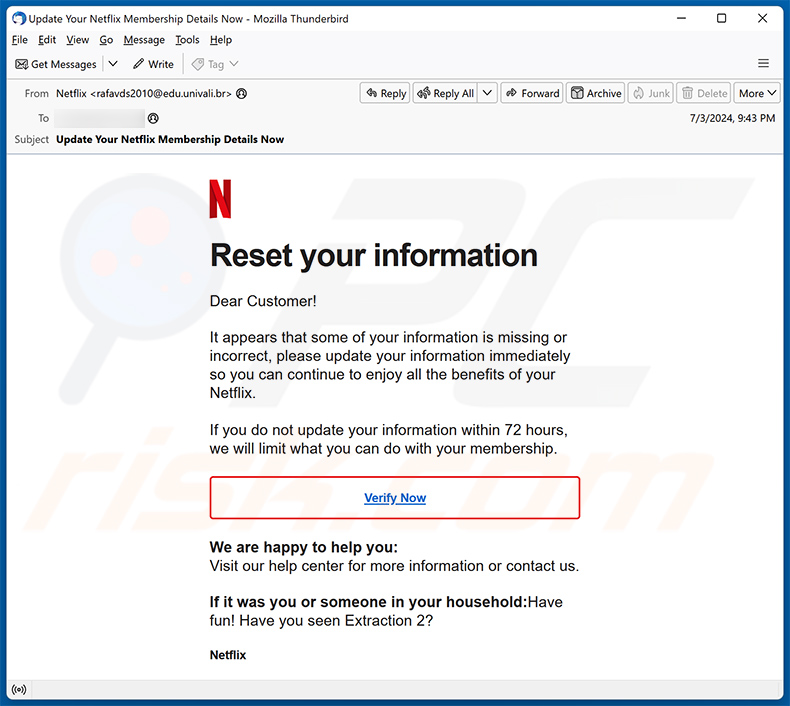
Text presented within:
Subject: Update Your Netflix Membership Details Now
Netflix
Reset your information
Dear Customer!
It appears that some of your information is missing or incorrect, please update your information immediately so you can continue to enjoy all the benefits of your Netflix.If you do not update your information within 72 hours, we will limit what you can do with your membership.
Verify Now
We are happy to help you:
Visit our help center for more information or contact us.
If it was you or someone in your household:Have fun! Have you seen Extraction 2?Netflix
Sample 2:
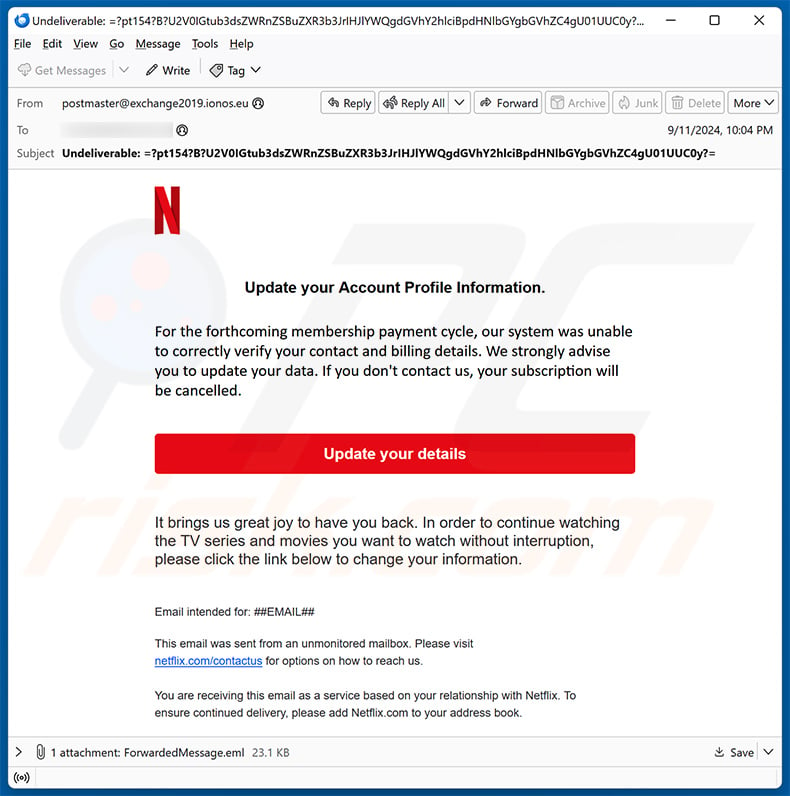
Text presented within:
Netflix
Update your Account Profile Information.
For the forthcoming membership payment cycle, our system was unable to correctly verify your contact and billing details. We strongly advise you to update your data. If you don't contact us, your subscription will be cancelled.
Update your detailsIt brings us great joy to have you back. In order to continue watching the TV series and movies you want to watch without interruption, please click the link below to change your information.
Email intended for: ##EMAIL##
This email was sent from an unmonitored mailbox. Please visit netflix.com/contactus for options on how to reach us.You are receiving this email as a service based on your relationship with Netflix. To ensure continued delivery, please add Netflix.com to your address book.
Keeping you secure is our first concern. If you would rather not click on any of the links in this email, you can find out more about our products and services by visiting neflix.com.
Privacy page | Fraud help | Contact us
Equal Housing Lender 2024 Netflix.
121 Albright Way, Los Gatos, CA 95032, U.S.A.
3D345-GO56091
Sample 3:
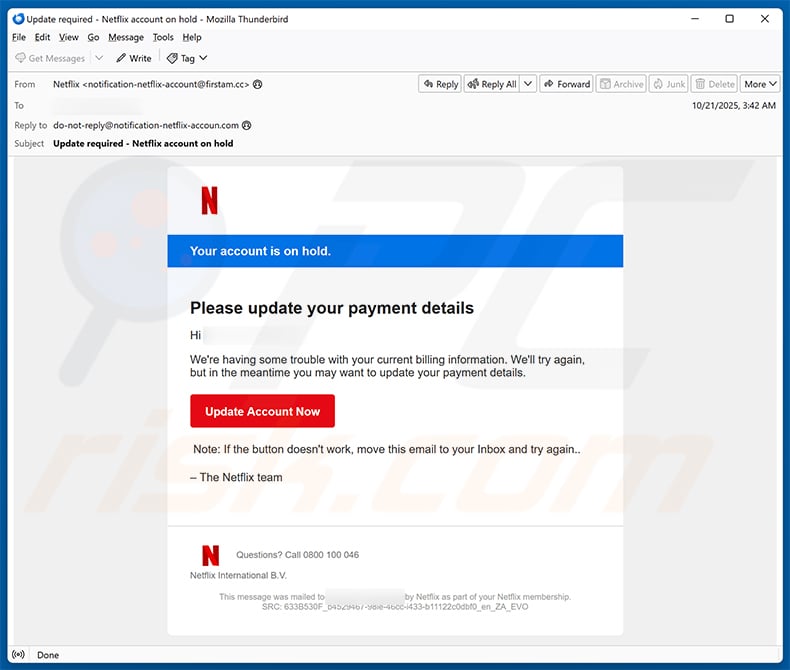
Text presented within:
Subject: Update required - Netflix account on hold
Netflix
Your account is on hold.
Please update your payment detailsHi ********,
We're having some trouble with your current billing information. We'll try again, but in the meantime you may want to update your payment details.
Update Account NowNote: If the button doesn't work, move this email to your Inbox and try again..
– The Netflix team
Netflix LogoQuestions? Call 0800 100 046
Netflix International B.V.
Screenshot of the promoted fake Netflix website:
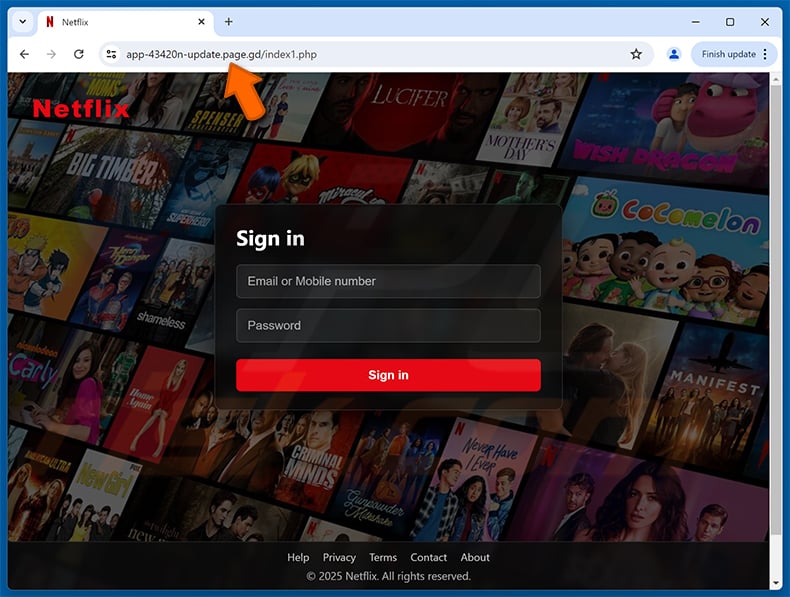
Instant automatic malware removal:
Manual threat removal might be a lengthy and complicated process that requires advanced IT skills. Combo Cleaner is a professional automatic malware removal tool that is recommended to get rid of malware. Download it by clicking the button below:
DOWNLOAD Combo CleanerBy downloading any software listed on this website you agree to our Privacy Policy and Terms of Use. To use full-featured product, you have to purchase a license for Combo Cleaner. 7 days free trial available. Combo Cleaner is owned and operated by RCS LT, the parent company of PCRisk.com.
Quick menu:
- What is "Netflix - Update Your Account Information" phishing email?
- Types of malicious emails.
- How to spot a malicious email?
- What to do if you fell for an email scam?
Types of malicious emails:
![]() Phishing Emails
Phishing Emails
Most commonly, cybercriminals use deceptive emails to trick Internet users into giving away their sensitive private information, for example, login information for various online services, email accounts, or online banking information.
Such attacks are called phishing. In a phishing attack, cybercriminals usually send an email message with some popular service logo (for example, Microsoft, DHL, Amazon, Netflix), create urgency (wrong shipping address, expired password, etc.), and place a link which they hope their potential victims will click on.
After clicking the link presented in such email message, victims are redirected to a fake website that looks identical or extremely similar to the original one. Victims are then asked to enter their password, credit card details, or some other information that gets stolen by cybercriminals.
![]() Emails with Malicious Attachments
Emails with Malicious Attachments
Another popular attack vector is email spam with malicious attachments that infect users' computers with malware. Malicious attachments usually carry trojans that are capable of stealing passwords, banking information, and other sensitive information.
In such attacks, cybercriminals' main goal is to trick their potential victims into opening an infected email attachment. To achieve this goal, email messages usually talk about recently received invoices, faxes, or voice messages.
If a potential victim falls for the lure and opens the attachment, their computers get infected, and cybercriminals can collect a lot of sensitive information.
While it's a more complicated method to steal personal information (spam filters and antivirus programs usually detect such attempts), if successful, cybercriminals can get a much wider array of data and can collect information for a long period of time.
![]() Sextortion Emails
Sextortion Emails
This is a type of phishing. In this case, users receive an email claiming that a cybercriminal could access the webcam of the potential victim and has a video recording of one's masturbation.
To get rid of the video, victims are asked to pay a ransom (usually using Bitcoin or another cryptocurrency). Nevertheless, all of these claims are false - users who receive such emails should ignore and delete them.
How to spot a malicious email?
While cyber criminals try to make their lure emails look trustworthy, here are some things that you should look for when trying to spot a phishing email:
- Check the sender's ("from") email address: Hover your mouse over the "from" address and check if it's legitimate. For example, if you received an email from Microsoft, be sure to check if the email address is @microsoft.com and not something suspicious like @m1crosoft.com, @microsfot.com, @account-security-noreply.com, etc.
- Check for generic greetings: If the greeting in the email is "Dear user", "Dear @youremail.com", "Dear valued customer", this should raise suspiciousness. Most commonly, companies call you by your name. Lack of this information could signal a phishing attempt.
- Check the links in the email: Hover your mouse over the link presented in the email, if the link that appears seems suspicious, don't click it. For example, if you received an email from Microsoft and the link in the email shows that it will go to firebasestorage.googleapis.com/v0... you shouldn't trust it. It's best not to click any links in the emails but to visit the company website that sent you the email in the first place.
- Don't blindly trust email attachments: Most commonly, legitimate companies will ask you to log in to their website and to view any documents there; if you received an email with an attachment, it's a good idea to scan it with an antivirus application. Infected email attachments are a common attack vector used by cybercriminals.
To minimise the risk of opening phishing and malicious emails we recommend using Combo Cleaner Antivirus for Windows.
Example of a spam email:

What to do if you fell for an email scam?
- If you clicked on a link in a phishing email and entered your password - be sure to change your password as soon as possible. Usually, cybercriminals collect stolen credentials and then sell them to other groups that use them for malicious purposes. If you change your password in a timely manner, there's a chance that criminals won't have enough time to do any damage.
- If you entered your credit card information - contact your bank as soon as possible and explain the situation. There's a good chance that you will need to cancel your compromised credit card and get a new one.
- If you see any signs of identity theft - you should immediately contact the Federal Trade Commission. This institution will collect information about your situation and create a personal recovery plan.
- If you opened a malicious attachment - your computer is probably infected, you should scan it with a reputable antivirus application. For this purpose, we recommend using Combo Cleaner Antivirus for Windows.
- Help other Internet users - report phishing emails to Anti-Phishing Working Group, FBI’s Internet Crime Complaint Center, National Fraud Information Center and U.S. Department of Justice.
Frequently Asked Questions (FAQ)
Why did I receive this email?
Spam emails are not personal. They are distributed in mass-scale campaigns – hence, thousands of users receive identical messages.
I have provided my personal information when tricked by this spam email, what should I do?
If you have disclosed your log-in credentials – immediately change the passwords of all potentially compromised accounts and contact their official support. However, if you've provided other private data (e.g., ID card details, passport photos/scans, ID card details, etc.) – contact relevant authorities without delay.
I have read a spam email but didn't open the attachment, is my computer infected?
No, merely opening an email will not initiate any system infection chains. Devices are infected when malicious attachments or links are opened.
I have downloaded and opened a file attached to a spam email, is my computer infected?
Whether your device was infected might depend on the opened file's format. If it was an executable (.exe, .run, etc.) – most likely, yes – your system was compromised. However, you may have avoided an infection if it was a document (.doc, .xls, .pdf, .one, etc.). These formats can need additional actions to jumpstart malware download/installation processes (e.g., enabling macro commands, clicking on embedded content, etc.).
Will Combo Cleaner remove malware infections present in email attachments?
Yes, Combo Cleaner is designed to detect and eliminate threats. It can detect and remove practically all known malware infections. Note that since high-end malicious programs usually hide deep within systems – running a full system scan is crucial.
Share:

Tomas Meskauskas
Expert security researcher, professional malware analyst
I am passionate about computer security and technology. I have an experience of over 10 years working in various companies related to computer technical issue solving and Internet security. I have been working as an author and editor for pcrisk.com since 2010. Follow me on Twitter and LinkedIn to stay informed about the latest online security threats.
PCrisk security portal is brought by a company RCS LT.
Joined forces of security researchers help educate computer users about the latest online security threats. More information about the company RCS LT.
Our malware removal guides are free. However, if you want to support us you can send us a donation.
DonatePCrisk security portal is brought by a company RCS LT.
Joined forces of security researchers help educate computer users about the latest online security threats. More information about the company RCS LT.
Our malware removal guides are free. However, if you want to support us you can send us a donation.
Donate
▼ Show Discussion